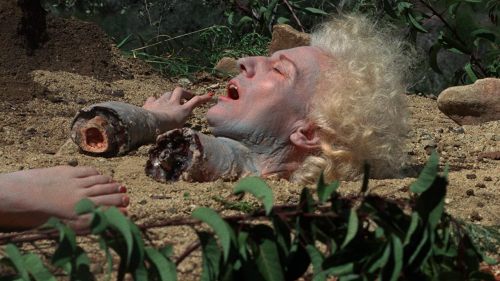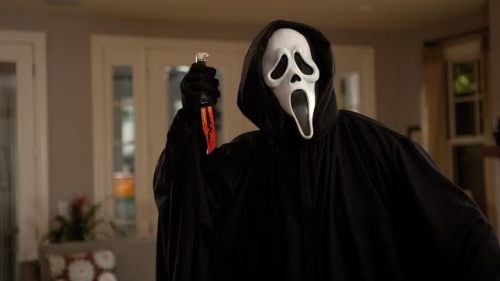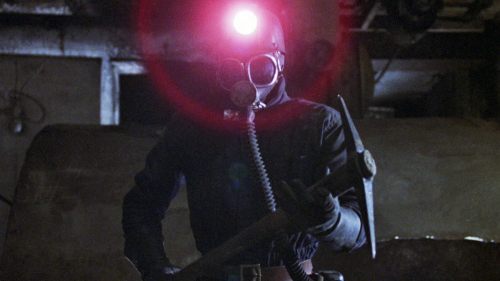Saved By The Final Girl
I was fifteen when I first watched Sally Hardesty escape into the back of a pickup truck, covered in blood and cackling like a goddamn witch.
All of her friends were dead. She had been kidnapped, tortured and even forced to feed her own blood to her cannibalistic captors’ impossibly shriveled patriarch. Being new to the horror genre, I was sure she was going to die.
Prior to witnessing Sally’s ordeal, I had just watched The Descent and Eden Lake, where both female protagonists endure intense physical and psychological trauma, only to be (seemingly) killed at the end. At the time, I figured this was the standard in horror, but was determined to find a film that went above and beyond. The truth is, I was going through horror movie after horror movie in an attempt to "find myself" onscreen.
It had been a few months since I survived a violent sexual assault, where I subsequently ran from my assailant, tripped, fell and fought like hell. I crawled home with bloody knees, makeup-stained cheeks and a new void in both my mind and heart. My sense of safety, my ability to trust others, my willingness to form new relationships and my love of spending time with people I cared about were all taken from me. This was the year I faked sick almost every week to get out of school. This was the year I couldn’t get out of bed. This was the year I stopped creating. I woke up screaming in the middle of the night. I locked every door twice. I wanted to die. My sense of self, my identity and any worth I had were stolen from me. There wasn’t anyone in my personal life that I could connect or relate to, so I turned to the fictional world in an effort to cope.
It wasn’t until I found the original The Texas Chain Saw Massacre that something clicked. It was Sally’s strength, and her resilience. It was watching her survive blows to the head from a hammer. It was watching her break free from her bonds and burst through a glass window. It was watching her get back up after she’d been stabbed. It was watching her crawl into the back of a truck, laughing as it drove away from Leatherface. She was the last one to confront the killer, and live. I remember sitting in front of the TV and thinking, There I am. That’s me.

The Final Girl is, of course, a well-worn staple of the horror genre, slasher movies especially. She’s the wholesome babysitter, the sweet summer camp counselor, the shy Girl Next Door. She won’t drink at the party, wouldn’t be caught dead with a cigarette and doesn’t have sex. She’s the first to notice that something’s wrong before any of her ill-fated friends – and she’s often the only one to make it out alive in the end.
The classic example is Laurie Strode, played by Jamie Lee Curtis, from 1978’s Halloween. In the first half of the film, Laurie is portrayed as shy, conservative and book-smart in contrast to her loud, over-sexed friends. Once the bloodshed starts, she kicks into survival mode as The Shape comes for her and the children she’s babysitting.
Of course, the Final Girl isn’t always the sweet ingénue. In Black Christmas, Jess Bradford (Olivia Hussey) is a smart sorority girl, but she’s also pregnant and ready to have an abortion independent of her neurotic boyfriend. Broken down by trauma, Scream’s Sidney Prescott (Neve Campbell) gives into her boyfriend’s advances – only to end up sleeping with the killer himself. Outside of the slasher genre, Buffy Summers (Sarah Michelle Gellar) of Buffy the Vampire Slayer was created with the intention to smash the Final Girl stereotype and, in author Jason Middleton’s words, be the heroine who gets to have sex with boys and still kill the monster.
So what does it mean for a female with PTSD to watch a strong woman kick slasher ass onscreen?
I can find a piece of myself – a trait, a quality, a survival tactic – in every Final Girl I love, and that connection is strangely and profoundly therapeutic. In Halloween, it’s Laurie’s selflessness. When she discovers the bodies of her friends and encounters Michael Myers for the first time, her immediate thought is to protect the kids she’s babysitting and put their lives before hers. In Friday the 13th Part 2, it’s the way Ginny Field (Amy Steel) is almost overwhelmingly human. After fighting off Jason, she escapes to a nearby cabin and hides underneath a bed. When Jason enters the cabin and slowly starts to walk around, Ginny does what any of us would do and literally pisses herself, as a stream of urine leaks out from underneath the bed. She isn’t the cliché hot girl who still manages to look hot while covered in blood. In that moment, Ginny reminds me that fighting for your life is anything but pretty. In A Nightmare on Elm Street, Nancy Thompson (Heather Langenkamp) uses her wit and intellect to outsmart Freddy Krueger. She studies a book on booby-traps and manages to Freddy-proof her entire house. When her boyfriend asks why she would be reading a book like that, she simply smiles and says, “I’m into survival.”
After my second assault, which took place only three years after the first, I found myself watching the Scream franchise twice a month for a little over a year. Years later, Sidney Prescott is still the Final Girl I always revisit. She endures the most intense physical and emotional trauma in each film, including painful loss and betrayal at the hands of those she loves, and still finds the will to move forward. After defeating the killers in the original Scream (one of which was her own boyfriend, revealed to be responsible for the death of her mother), Sidney still finds it in her to pursue a normal life and go to college. After her new life is destroyed in the second film, she goes into hiding in order to protect herself. While in hiding, she becomes a crisis counselor for an abused women’s hotline. Following the traumatic events in Scream 3, Scream 4 begins with Sidney on a press tour to promote her book, Out of Darkness, a memoir about survival. Across four films, over fifteen years, Sidney keeps going. There’s a new Ghostface in each installment out to kill Sidney, to take everything away from her - including the people she cares for most - but she’s too smart, too fast and too goddamn strong. For me, Sidney is the ultimate Final Girl. Not only to do we get to watch her survive; we get to watch her cope. Watching her move forward helped me find it in myself to get out of bed every day, and eventually write about my own experiences in hopes of making someone else out there feel less alone.
Being a survivor of assault is the loneliest thing I have ever experienced. They say everyone knows someone, but at fifteen, I didn’t know anyone. I knew what had happened to me, especially with the violent nature of it all, wasn’t a normal thing that happened to other people. It wasn’t until I saw these women fighting for their lives – and winning – that I finally started to feel less alone. My heroes were fictional, sure, but they looked just like me. They fought just like me. They survived just like me.
I take pride in calling myself a Final Girl. I take pride in the fact that I fought my own Michael Myers, my own Ghostface, and lived. I take pride in my strength, in my resilience and my ability to push forward and cope.
I’m into survival.



